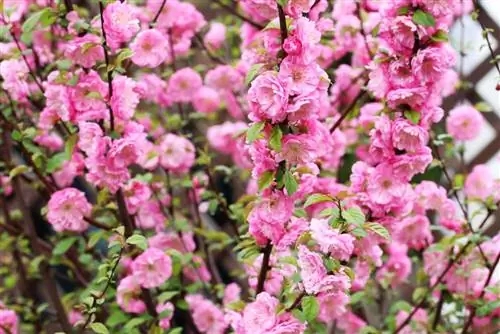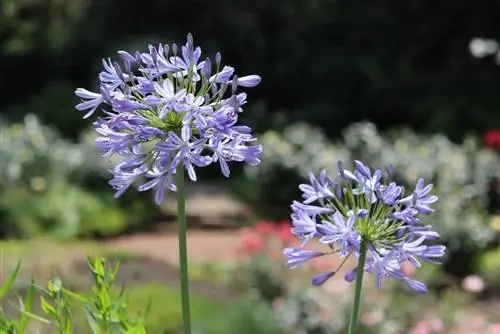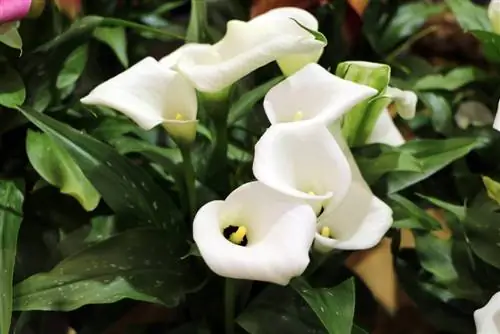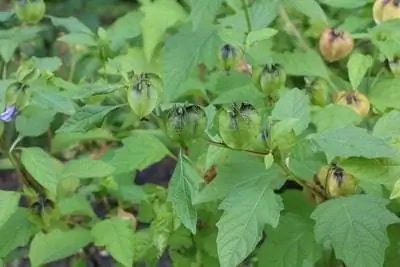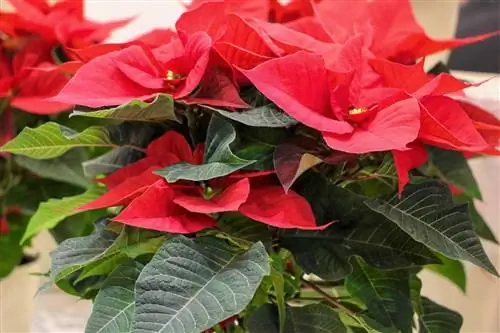- Author admin [email protected].
- Public 2023-12-17 03:39.
- Last modified 2025-01-24 12:45.
The Christmas rose is also known as the snow rose and belongs to the hellebore genus. Depending on the variety, the beauty with the large flowers blooms a little earlier or later. By combining several perennials, the flowering period can be extended from the end of November to March. Christmas roses look best when planted in groups of 3 or 5 plants, not too close together in the garden.
Location
The Christmas rose doesn't like it too dry and not too sunny. It loves a bright location that is somewhat in partial shade. The ideal place in the garden for the white-flowering beauty is, protected from the wind, near low-growing trees or perennials. Christmas roses love deeply loosened and somewhat loamy soil that should have a certain amount of lime. Under no circumstances does the Christmas rose like acidic soils. The buttercup plant likes to stay in the same location for many years and doesn't like it when it is moved to other places in the garden more often. If you want to keep the Christmas rose in a pot, you should give it a spacious container with plenty of good soil. Christmas roses like a good supply of water but not waterlogging. Good drainage is therefore important in the bucket to ensure that water is removed. Expanded clay, pottery shards or pebbles as well as other materials are suitable for this.
Fertilizing and care
Christmas roses are frugal and require little fertilizer. It is sufficient to provide them with well-ripened compost once in spring and once in August. The Christmas rose is happy about a small dose of lime in the fall every 2nd or 3rd year. If you don't have compost in your garden, you can also feed the perennial with a little liquid fertilizer or fertilizer granules. In dry summers, care should be taken to ensure a good water supply. However, there should be no waterlogging. By hoeing and working the soil too intensively, the perennial feels disturbed and begins to suffer. If you want to avoid weeds in the perennial bed, it is recommended to mulch the soil around the Christmas rose with dried grass clippings, leaves or other materials. Pruning is not necessary because the Christmas rose does not become woody. It is therefore completely sufficient if the withered flowers and leaves are removed regularly. Gloves should be worn because the sap of the Christmas rose is irritating to the skin and poisonous.
Pests
Black spot disease sometimes affects plant leaves. This is the case if the Christmas rose is not in the optimal location or if it has been watered too much, only then will it be prone to black spot disease, with the Latin name Coniothyrium hellebori. This fungal disease can be avoided by using less fertilizer, good drainage and the right location. If this fungal disease does occur, the affected leaves should be removed immediately and the location problems solved. If the fungal disease has already spread widely, a total pruning is recommended, but the perennial can cope well. In rare cases, lice may infest the Christmas rose in spring. Cold broths help against this
- Stinging nettles
- garlic
- Wormwood and
- tansy.
The infestation of lice is an indicator that the Christmas rose may have been fertilized too much or is weakening for other reasons.
Propagate
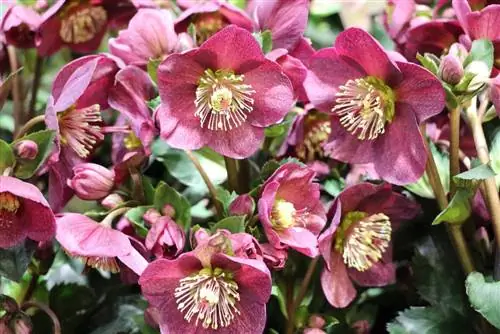
The Christmas rose develops into a stately perennial over the years. If you want to divide them, it is best to do this in spring after flowering. During the summer, the young plants should be regularly supplied with water and a little fertilizer so that they have grown well by late autumn and have the strength to produce flowers. The Christmas rose can also be propagated from seeds. To do this, the seeds are scattered in bowls in autumn and placed outdoors well away from birds and mice. The seeds of the Christmas rose are frost germinators and will only germinate when they have received some frost.
Wintering
The Christmas rose is completely hardy and doesn't actually need any special winter protection. If you want to be on the safe side, you can put out some brushwood as protection in the first year. Then the Christmas rose will get through the first year after being planted without any problems. Later, the buttercup plant no longer needs any special winter protection. However, Christmas roses in pots need better protection. In this case, it makes sense to wrap the pot well in fleece and bubble wrap or to protect the root area with other materials such as jute.
Plant profile
The Christmas rose has one or two pale oval bracts on the stem. The flowers of the Christmas rose are terminal and stand individually on unbranched stems. The diameter of the flower is five to ten centimeters. The perianth is either white or reddish and is composed of five ovoid sepals. During flowering, the flower bracts are greenish or red and last for a very long time. The actual petals have a bag shape, are yellow to yellow-green and are surrounded by nectar flowers. The nectar leaves have a more intense scent than the perianth and secrete a lot of nectar.
Tip:
The main flowering time for the Christmas rose is from February to April, although, depending on the snow and altitude, it can start blooming as early as November.
Overwintering as an ornamental plant
- Christmas or snow roses can easily be overwintered as container or potted plants. They need a cool place. A garage with a window, a hallway or a stairwell is completely sufficient. However, it should be noted that the plant has wintergreen leaves and needs to receive sufficient light for this. Watering can be sporadic.
- The natural home of the Christmas rose is the eastern Northern and Southern Alps, as well as the Apennines and the northern Balkans. It can be found up to an altitude of 1,900 meters. In Germany, the Christmas rose is only native to Bavaria. The preferred location of the Christmas rose is on bushy slopes, light beech and mixed beech forests as well as spruce forests and in the south of downy oak forests.
- This plant species is very often cultivated, but it rarely goes wild. The ingredients saponins and protoanemonin make the Christmas rose very poisonous. According to the Federal Species Protection Ordinance, the Christmas rose is particularly protected and is on the red list in Germany.
Conclusion
The Christmas rose is undemanding and does not require much care and is easy to propagate. Because it blooms from winter to spring, it delights the garden owner with its wonderful flowers, even when it is snowing and freezing outside. That's why it's also called the snow rose. Over the years, the white beauty develops into a stately perennial and delights with its countless flowers for many weeks. A sister of the Christmas rose is the Lenten rose, which only blooms in spring and is available in different shades of red.


